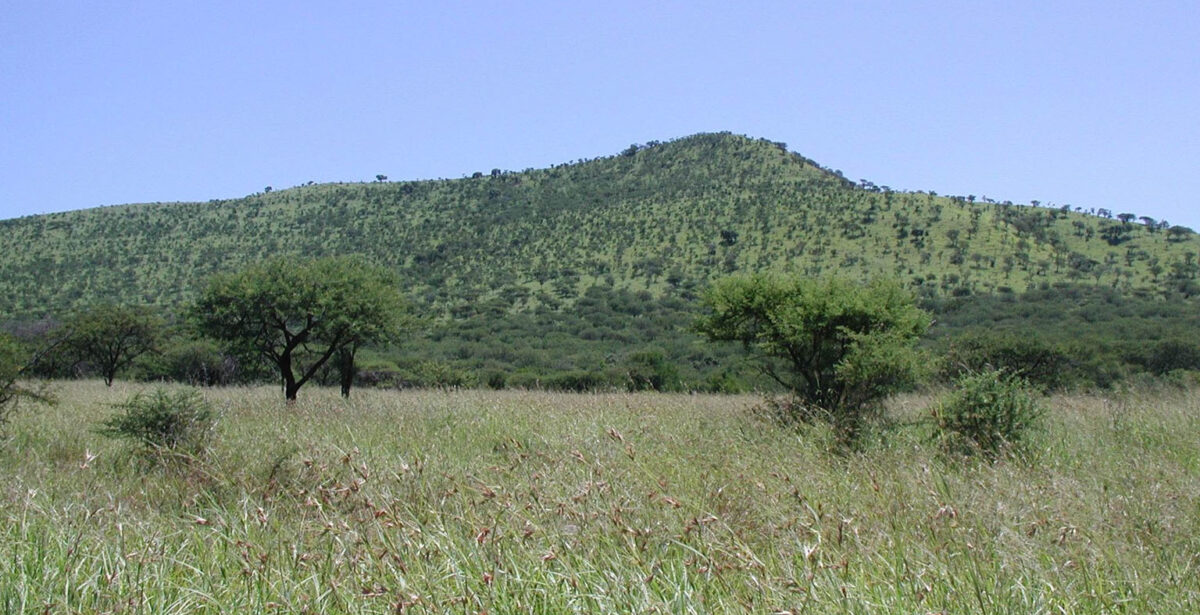Page snapshot: An overview of the world's tropical grassland ecosystems and their common species.
Topics covered on this page: African savannas; Overview of African savannas; African savanna species spotlights; Australian tropical savannas; Overview of Australian tropical savannas; Australian tropical savanna species spotlights; Indian savannas and grasslands; Overview of Indian savannas and grasslands; Terai-Duar savanna and grasslands; Indian species spotlights; South American cerrado; Overview of the cerrado; Cerrado species spotlights; Resources.
Credits: Funded by the National Science Foundation. Any opinions, findings, and conclusions or recommendations expressed in this material are those of the author(s) and do not necessarily reflect the views of the National Science Foundation. Page by Naomi Schulberg (2023), with some species profiles by E.J. Hermsen (2023).
Updates: Page last updated August 8, 2023.
Image above: Savanna in Hluhuwe-Imfulozi Park, South Africa. Photo by Paul Bolstad, University of Minnesota (Bugwood.org image number UGA1125014, Creative Commons Attribution 3.0 license).
Introduction
Tropical grasslands, many of which are savannas, are located between 30ºN and 30ºS of the equator. They are found in South America, Africa, Asia, and Australia. Tropical grasslands experience temperatures that do not drop below freezing and have distinct wet and dry seasons. Levels of rainfall range between 50 to 130 centimeters (about 20 to 51 inches) per year.
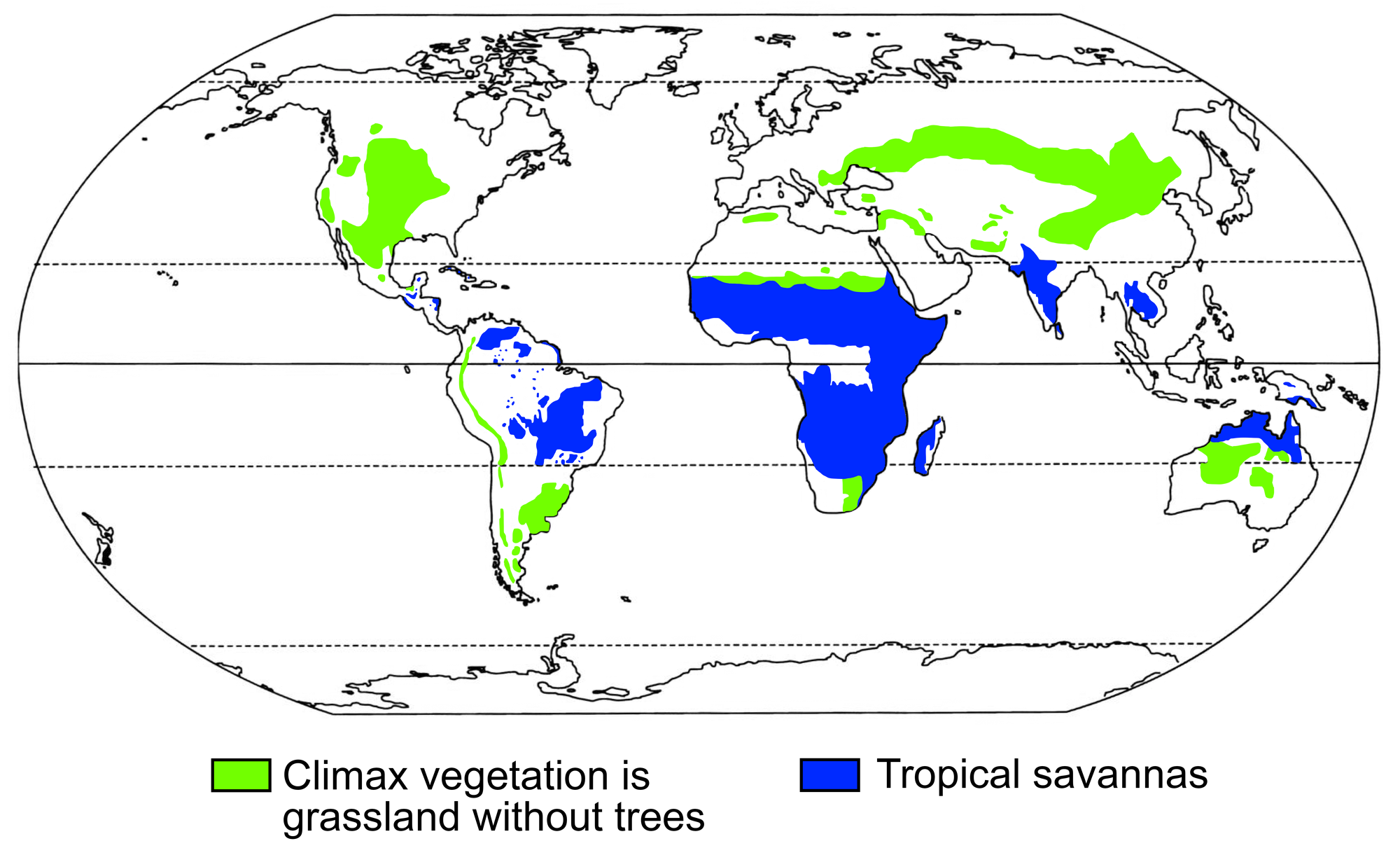
Modern distribution of grasslands (meaning biomes in which the climax vegetation is grass-dominated and lacks trees) and tropical savannas. Modified from figure 1 in Jacobs et al. (1999) Annals of the Missouri Botanical Garden 86: 590-643 (Biodiversity Heritage Library, Creative Commons-NonCommercial-ShareAlike 3.0 Unported license, image cropped, resized, reshaded and relabeled).
African savannas
Overview of African savannas
African savannas are tropical grasslands that span from 15ºN to 30ºS, covering almost half of the continent and 29 different countries. The African savanna ecosystem supports some trees, shrubs, and forbs, but remains grass dominated. Notable trees include baobabs (Adansonia) and acacias (Senegalia and Vachellia).
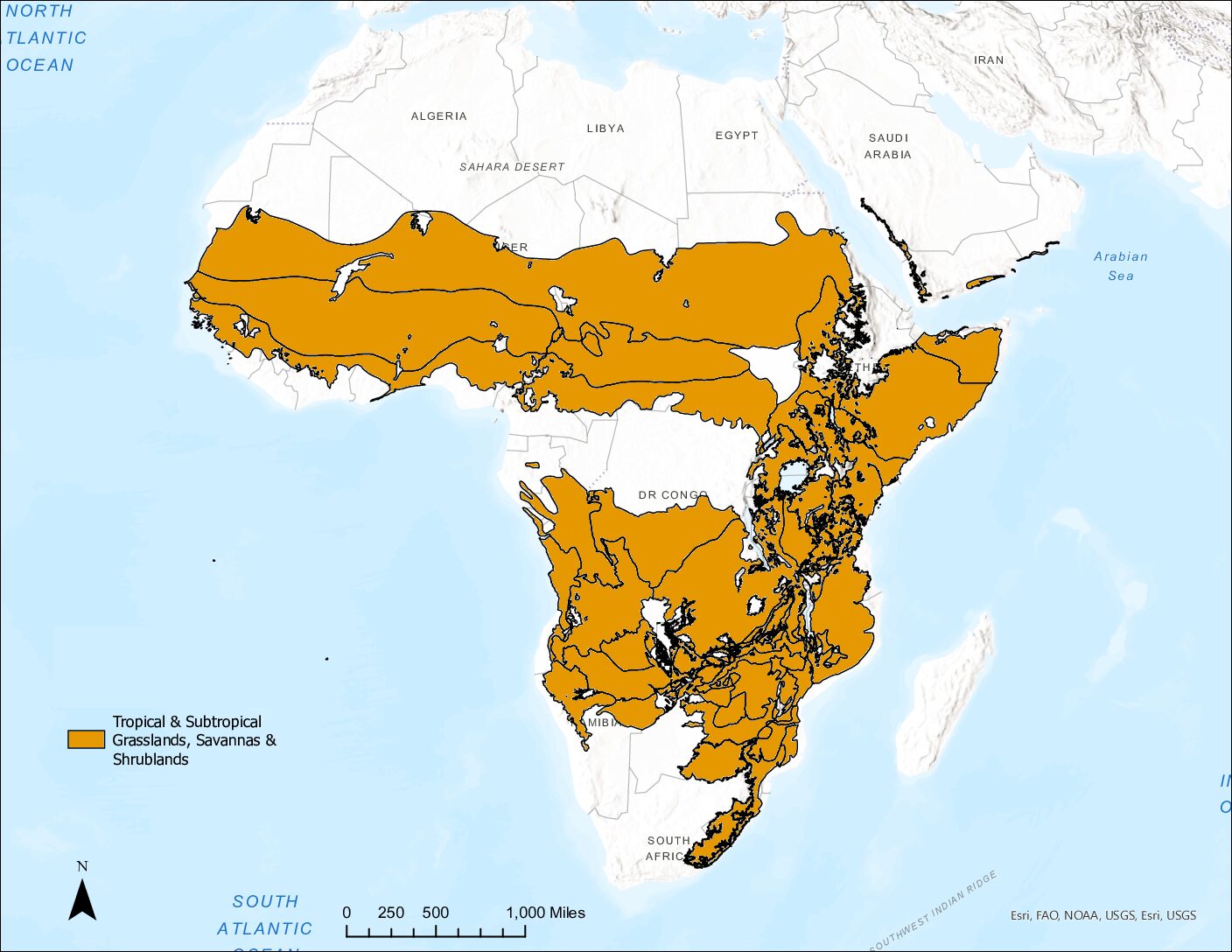
Map of tropical savannas in Africa. Map created by N. Schulberg.
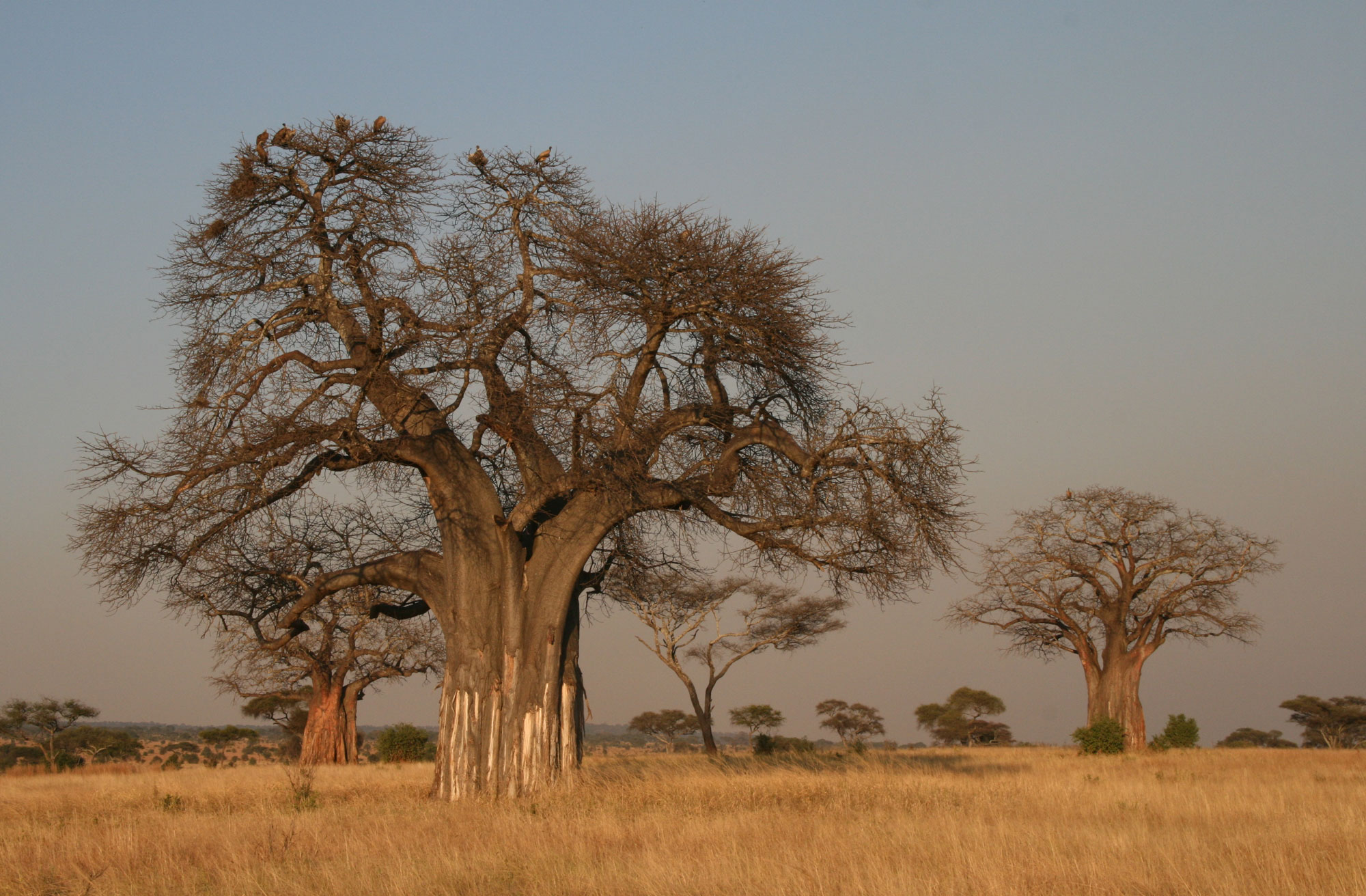
African baobabs (Adansonia digitata) on the savanna, Tarangire National Park, Tanzania, 2019. Photo by Yoky (Wikimedia Commons, Creative Commons Attribution-ShareAlike 3.0 Unported license, image resized).
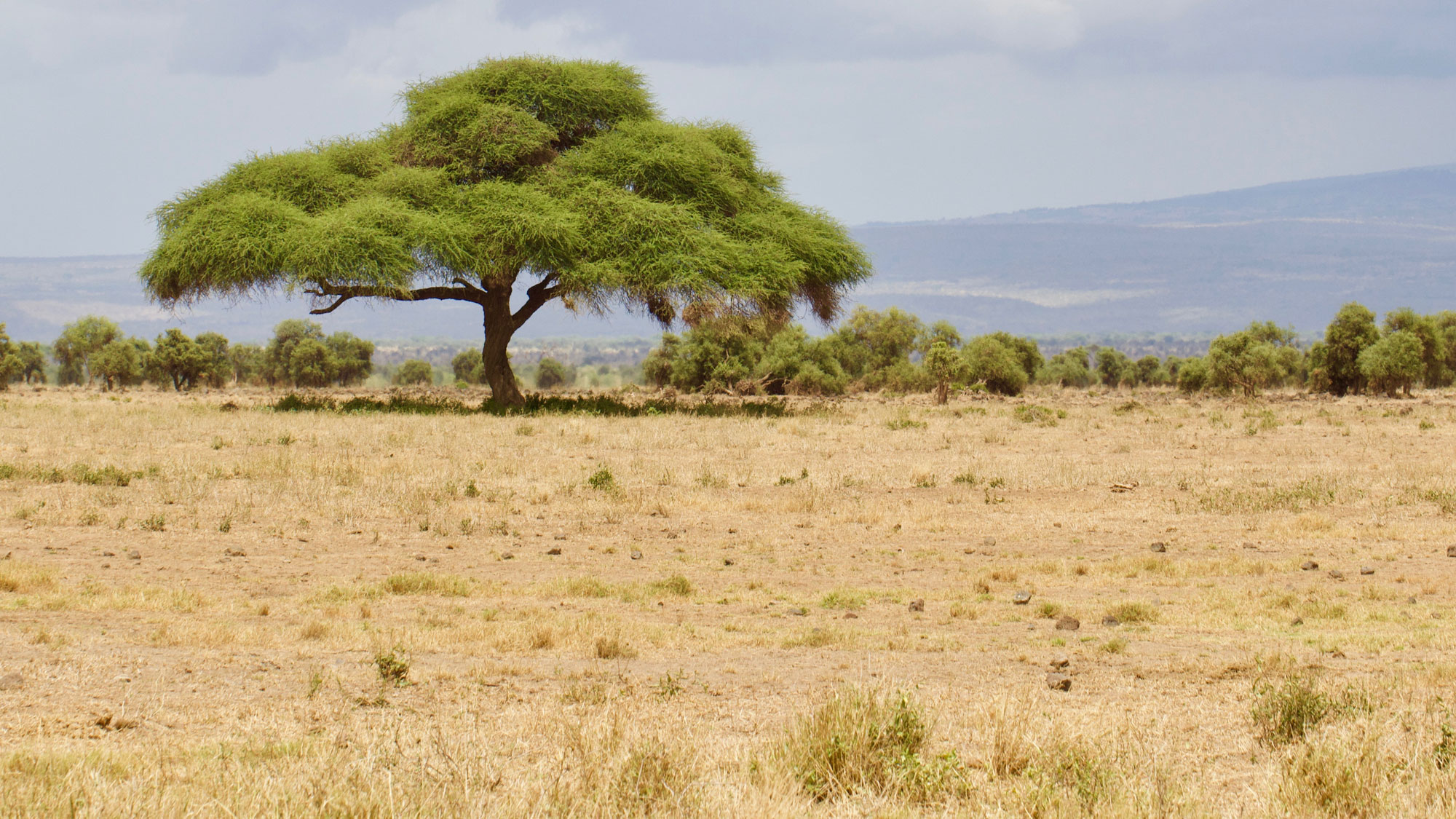
A large acacia tree on the savanna, Amboseli National Park, Kenya, 2019. Photo by Kandukuru Nagarjun (flickr, Creative Commons Attribution 2.0 Generic license, image resized).
Most grass species in the savannas are perennials. During the dry season, fires kill the shoot systems of the grasses, but their underground organs (roots and rhizomes) remain in the soil, and they send up new shoots during the next wet season. African savanna grasses are mostly C4 grasses, except in areas with relatively high winter rainfall. These areas support a mixture of C3 and C4 species.
The temperature remains warm throughout the year across the African savanna, with distinct wet and dry seasons. Rainfall is concentrated to around half of the year and is followed by an extended period of drought with frequent wildfires. The dry season occurs from October to March in the southern hemisphere and from April to September in the northern hemisphere. Overall, the region receives an average of 1000 to 1500 millimeters (40 to 60 inches) of rainfall each year.
The savannas are home to both grazing and browsing animals, with about 45 species of mammals and 500 species of birds. Examples of animals living in the savannas include African elephants (Loxodonta), giraffes (Giraffa camelopardalis), zebras (Equus subgenus Hippotigris), cheetahs (Acinonyx jubatus), lions (Panthera leo), African buffalos (Syncerus caffer), and rhinos (Ceratotherium simum and Diceros bicornus).

Elephants in a savanna, Taita Hills, Kenya. Photo by Christopher T. Cooper (Wikimedia Commons, Creative Commons Attribution 3.0 Unported license).
African savanna species spotlights
Bermuda grass (Cynodon dactylon)
Bermuda grass is a perennial C4 grass that grows across the African savannas and is also native to large parts of Eurasia and Australia. It grows in open areas that are prone to disturbance and is often the first species to grow after a disturbance. Known as a creeping grass, it develops roots when a node touches the ground, forming dense mats.
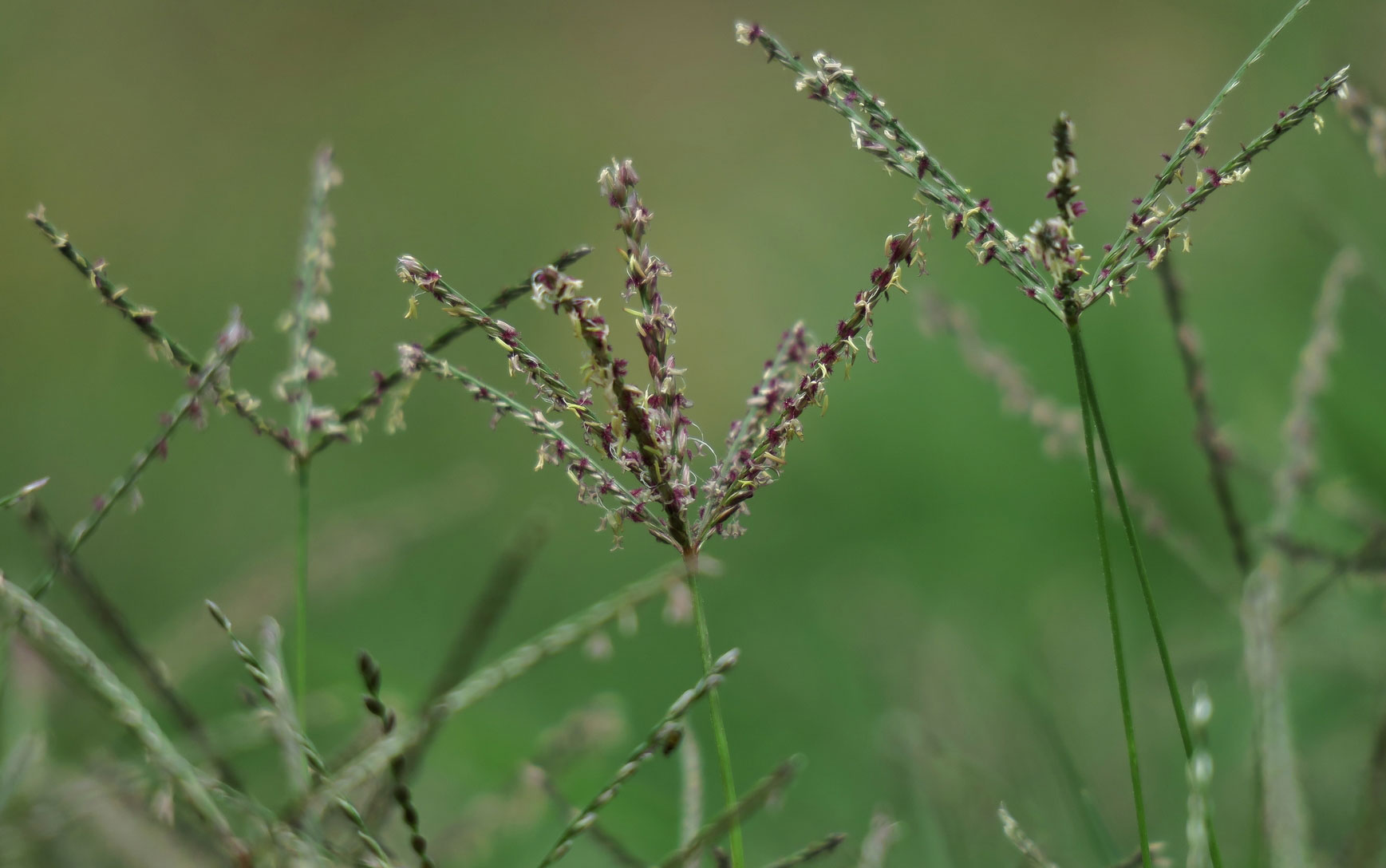
Bermuda grass (Cynodon dactylon), South Africa. Photo by wonderwalker (iNaturalist photo 61643335, Creative Commons Attribution-NonCommercial 4.0 International license, image cropped).
Rhodes grass (Chloris gayana)
Rhodes grass is a perennial C4 grass. It is commonly found in disturbed habitats and grows to heights of 1.5 to 3 meters (about 5 to 10 feet). Its smooth, hairless leaves grow to up to 50 centimeters (about 20 inches) long. Spikelets are brown to orange.
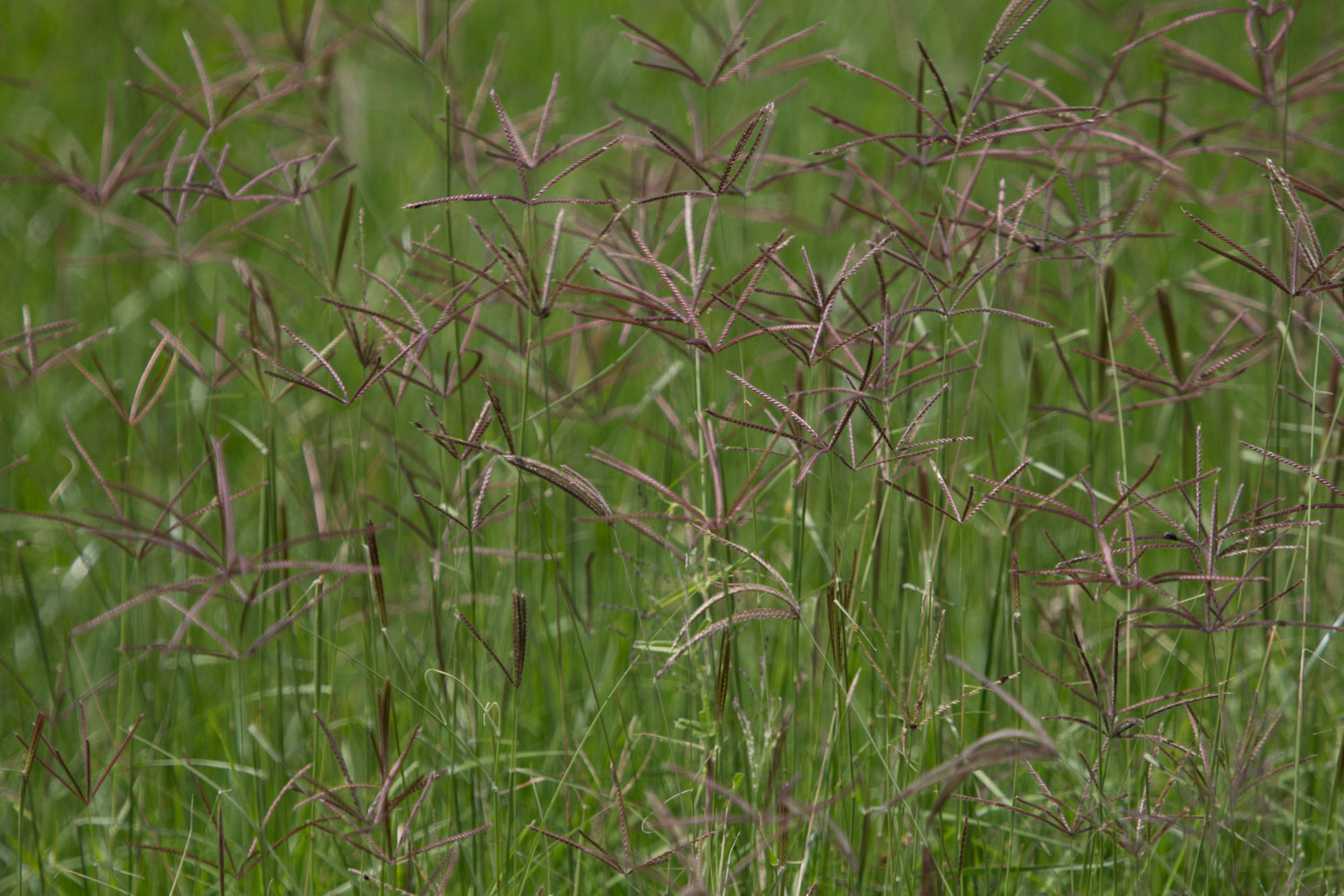
Rhodes grass (Chloris gayana), Tanzania. Photo by avocat (iNaturalist photo 21557687, Creative Commons Attribution-NonCommercial 4.0 International license).
Red oat grass (Themeda triandra)
Red oat grass is a perennial C4 grass. It is also found in Australia, where it is known as kangaroo grass. It is relatively slow growing and usually found in areas which are less prone to disturbance from grazing. It grows to be up to 1.5 meters (5 feet) tall. Flowering generally occurs from summer to fall, and the seed head is large, red, and drooping.

Red oat grass (Themeda triandra), Kruger National Park, South Africa. Photo by Bernard DUPONT (Wikimedia Commons, Creative Commons Attribution-ShareAlike 2.0 Generic license, image resized).
Napier grass (Cenchrus purpureus)
Napier grass is an evergreen perennial C4 grass found in many African countries, such as Sierra Leone, Ethiopia, Angola, Zimbabwe, and Mozambique. It grows in clumps that are between 3 and 7 meters (about 10 to 23 feet) tall. Its leaf blades have a distinctive white central vein.
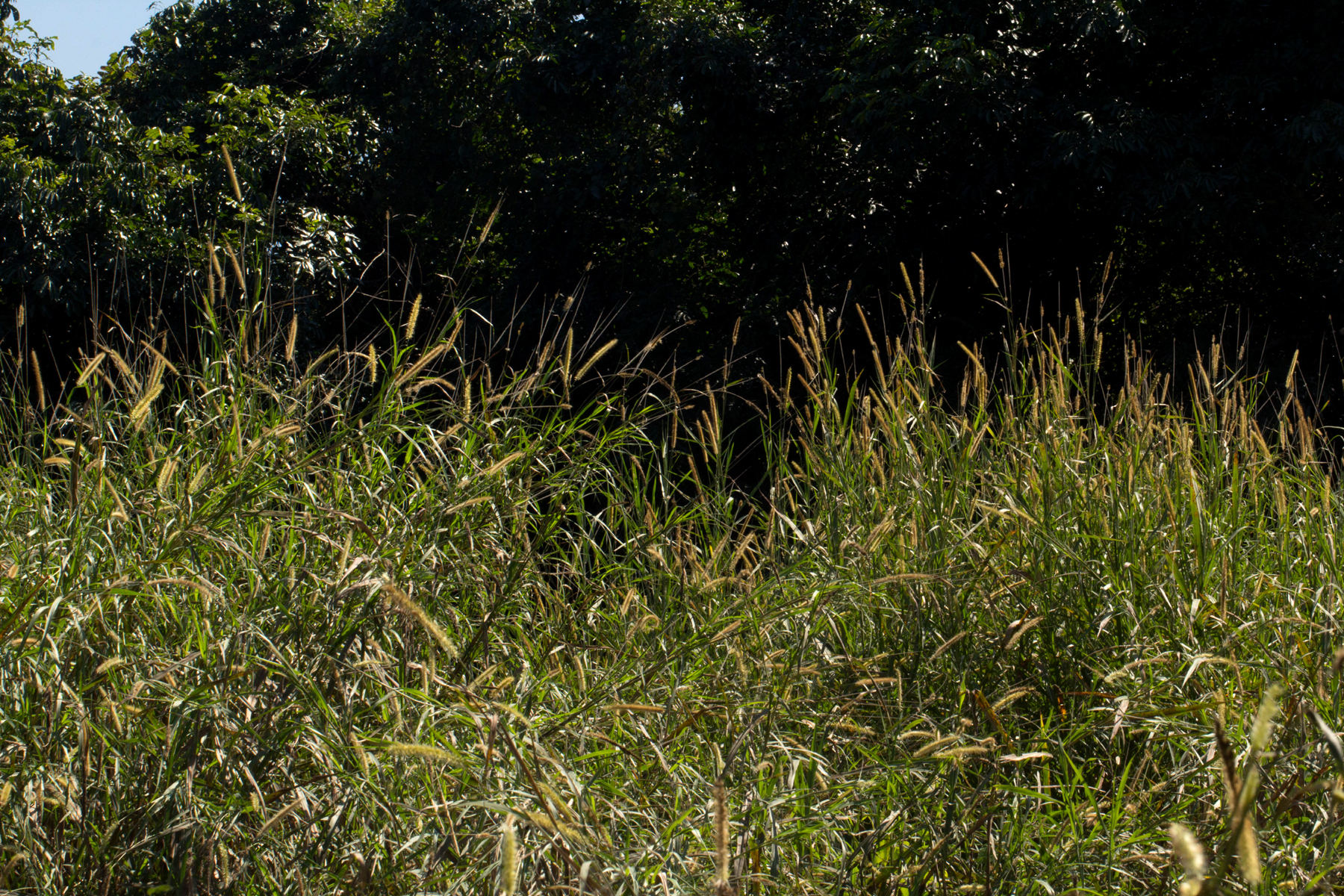
Napier grass (Cenchrus purpureus), Mozambique. Photo by Bart Wursten (iNaturalist photo 229720293, Creative Commons Attribution-Noncommercial 4.0 International license).
Australian tropical savannas
Overview of Australian tropical savannas
Savannas cover a broad area of the Australian continent, spanning both tropical and subtropical regions. Overall, Australian grasslands are split into 13 ecoregions. Climate ranges from humid subtropical to semiarid. The Australian tropical savannas span much of Northern Australia, including the Northern Territory and Queensland.
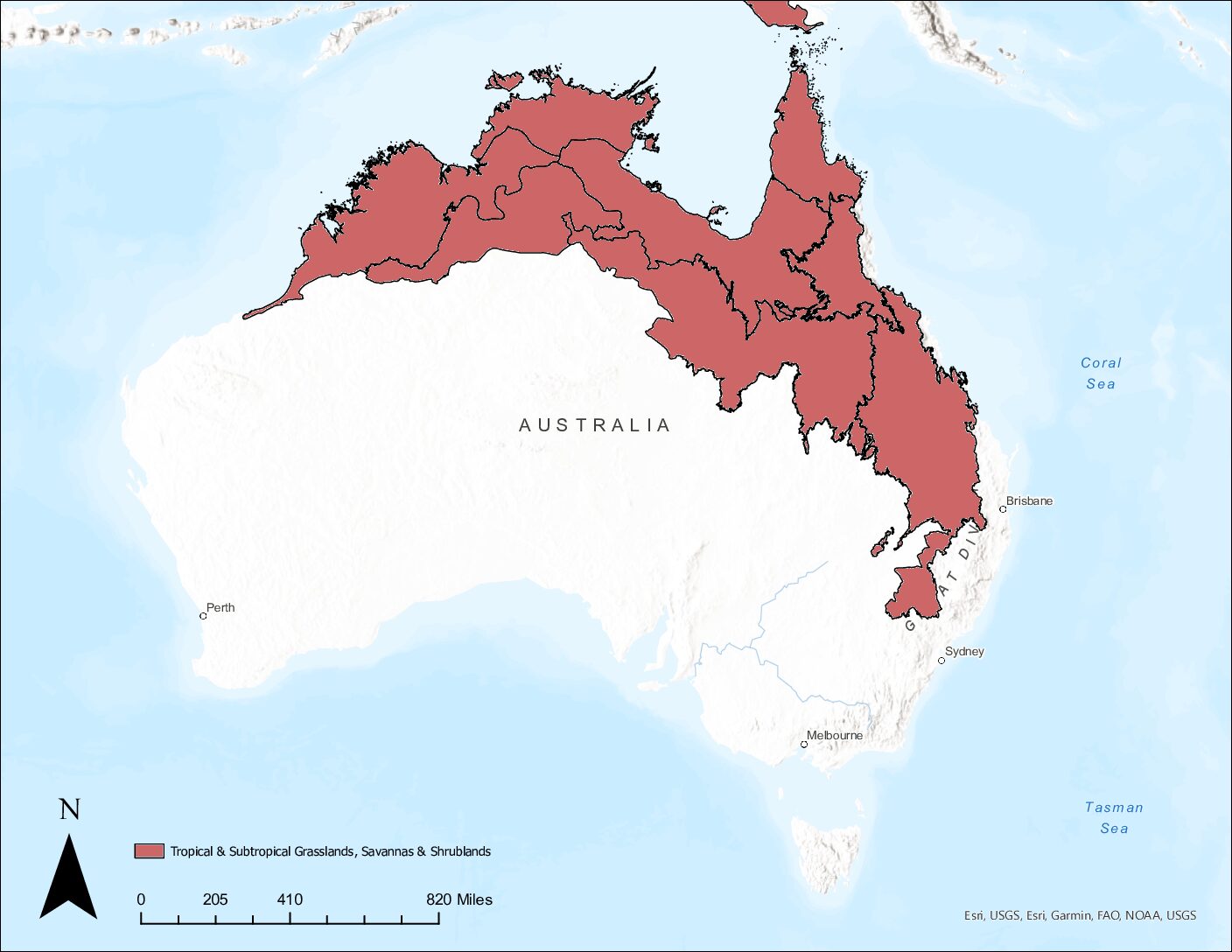
Map of grasslands in Australia, created by N. Schulberg.
Australian tropical savannas have distinct wet and dry seasons. The dry season is in the winter and spans from May to October; the wet season spans from December to March. Fires are common during the dry season, while rainfall occurs frequently during the wet season. Temperatures stay above freezing year round. During the summer, temperatures can get to as high as 50ºC (122ºF), but usually stay around 30ºC (86ºF).
Other plants in the flora include various species of eucalyptus (Eucalyptus). The most dominant animals are marsupials (mammals with a pouch). Animals such as the saltwater crocodile (Crocodylus porosus) are common, as are birds such as grass finches (species in the tribe Erythrurini) and corellas (Cacatua subgenus Licmetis).
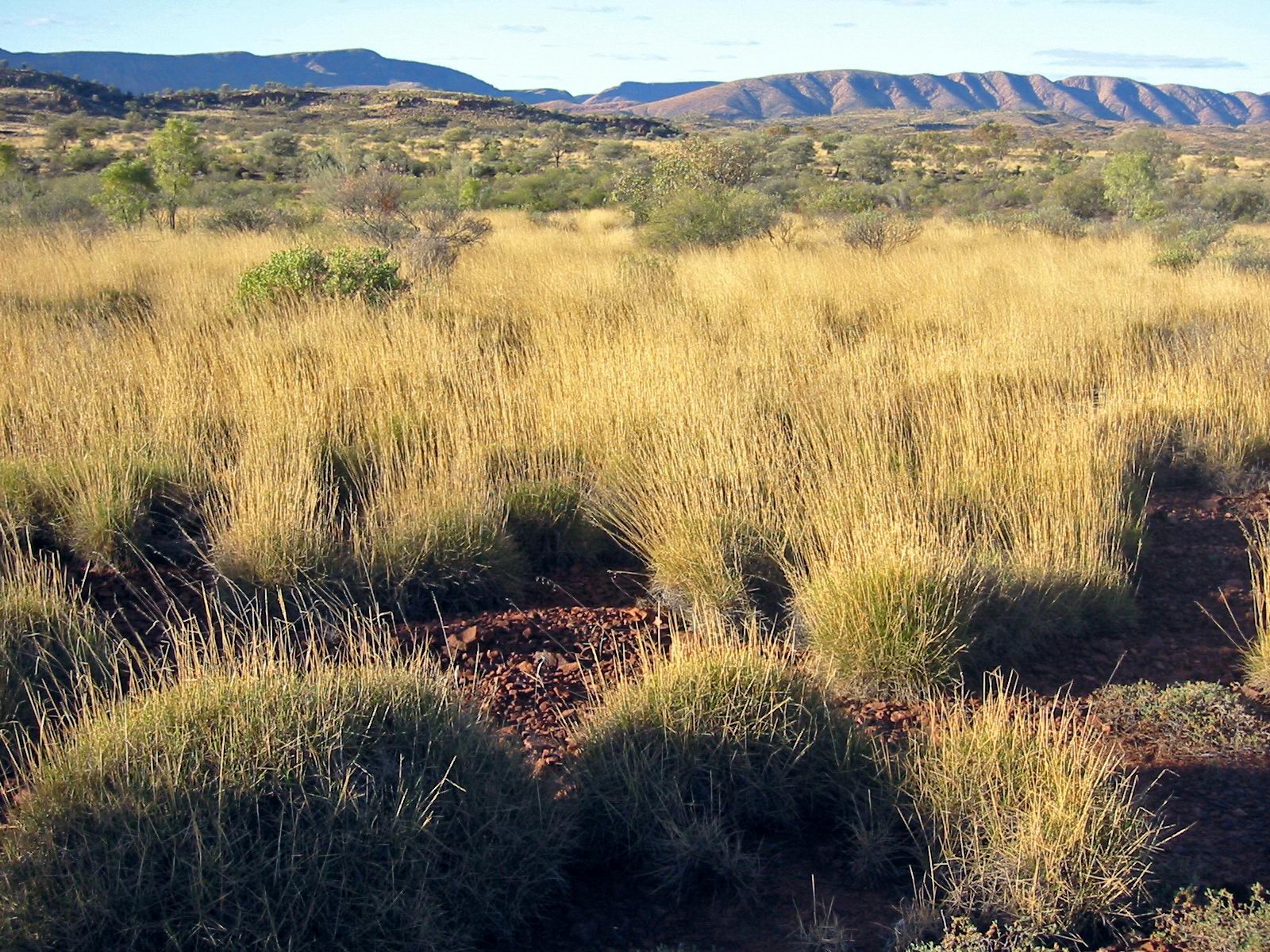
Australian tropical savanna, MacDonnell Ranges, Northern Territory, Australia. Photo by Thomas Schoch (Wikimedia Commons, Creative Commons Attribution-Share Alike 2.5 Generic license).
Australian tropical savanna species spotlights
Notable species of the Australian tropical savanna also occur in the Australian temperate savanna.
Speargrass (Austrostipa scabra)
Speargrass is a perennial C3 grass found in the temperate and tropical grasslands of Australia. It occurs across all Australian states. It is a tufted grass and grows to heights of up to 70 centimeters (about 27.5 inches). It flowers from October to January.
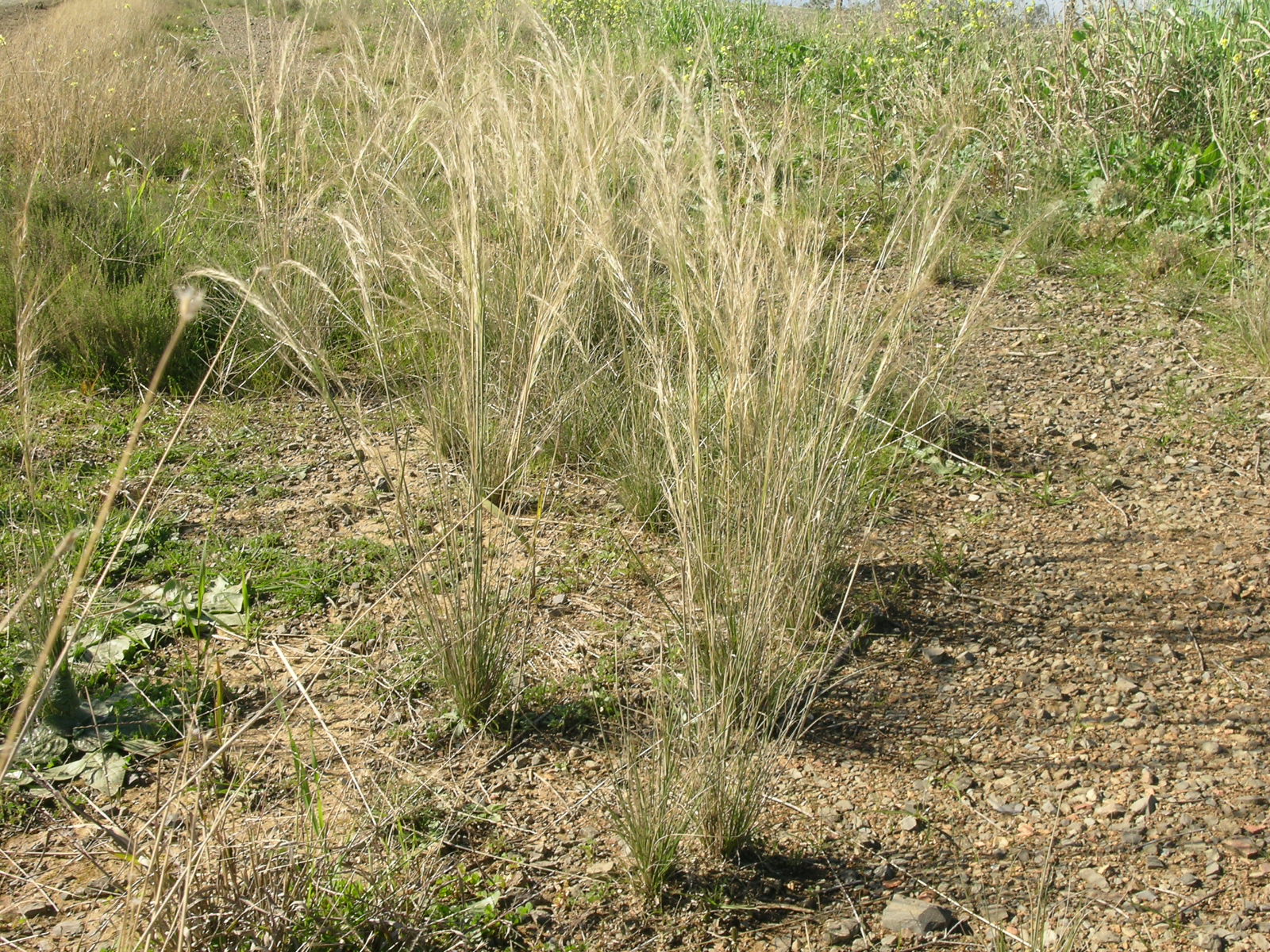
Speargrass (Austrostipa scabra). Photo by Harry Rose (flickr, Creative Commons Attribution 2.0 Generic license).
Curly windmill grass (Enteropogon acicularis)
Curly windmill grass is a perennial C4 grass found in the temperate and tropical grasslands of Australia. It is generally found in drier areas of eastern Australia and is drought tolerant. It grows to heights of 1 meter (more than 3 feet) and is endemic to Australia.

Curly windmill grass (Enteropogon acicularis). Photo by Mark Marathon (Wikimedia Commons, Creative Commons Attribution-Share Alike 3.0 Unported license).
Windmill grass (Chloris truncata)
Windmill grass is a biennial to perennial C4 grass found in the temperate and tropical grasslands of Australia. It grows in tufts and reaches heights of 50 centimeters (about 20 inches). It is generally found in areas with relatively high rainfall. It flowers from the spring to autumn, but mainly in the summer. Florets turn from green to purple to black with increasing maturity and ripeness.

Windmill grass (Chloris truncata). Photo by Harry Rose (flickr, Creative Commons Attribution 2.0 Generic license).
Red leg grass (Bothriochloa macra)
Red leg grass is a perennial C4 grass found in the tropical and temperate grasslands of Australia. It is a grass that grows in tufts with green and maroon leaves and produces red flowers during the summer and autumn.
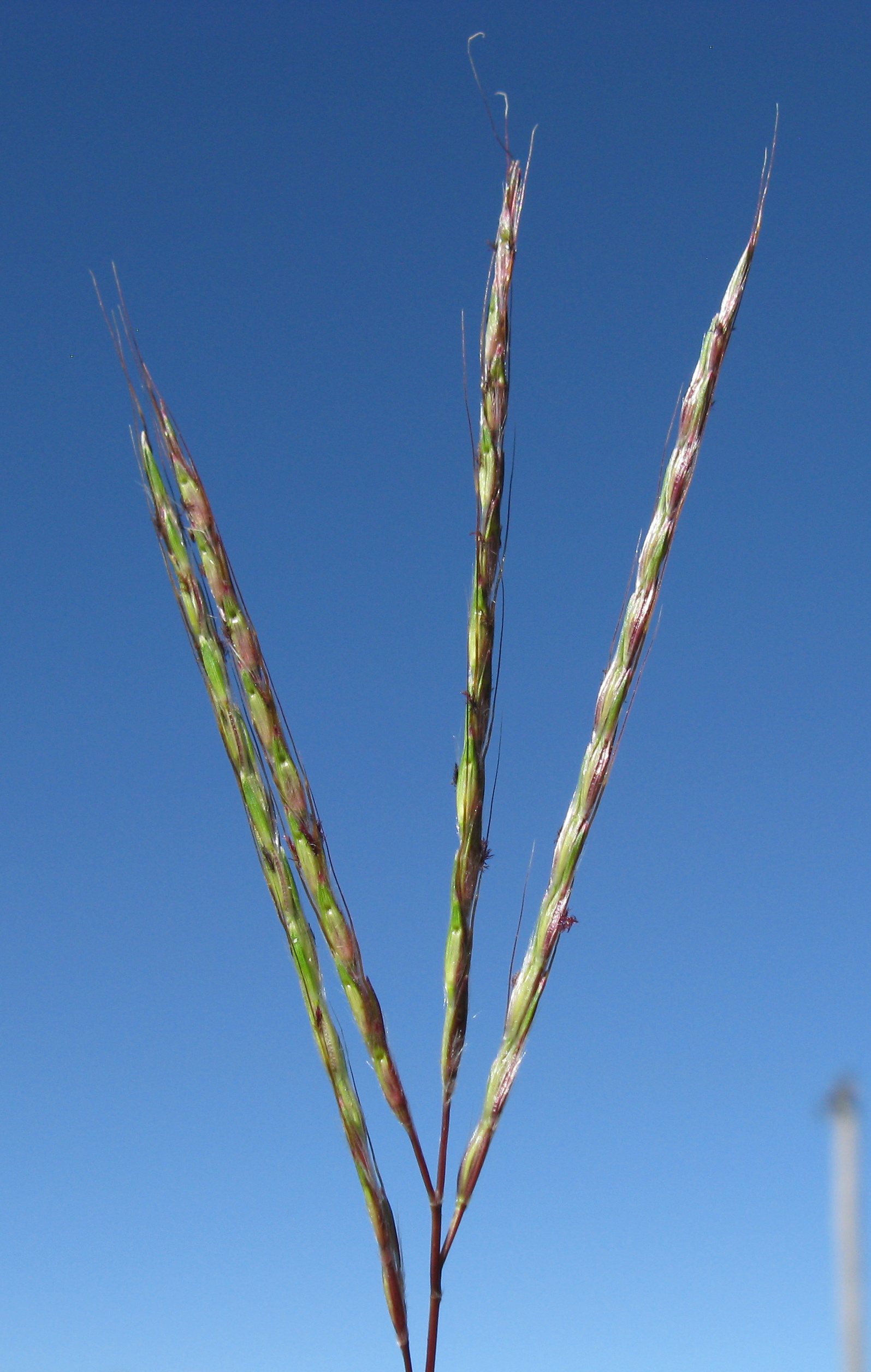
Red leg grass (Bothriochloa macra). Photo by Harry Rose (flickr, Creative Commons Attribution 2.0 Generic license).
Indian savannas and grasslands
Overview of Indian savannas and grasslands
Grasslands in India include sub-Himalayan grasslands, montane grasslands, tropical savannas, coastal grasslands, and riparian grasslands. Grasslands in India are some of the world’s oldest known grasslands, dating back to the Late Cretaceous (more than 66 million years ago). The grasslands of India are an endangered biome. Less than 2% of the grasslands remain, as much of the savanna and grassland in India has been converted to agricultural land.
The majority of the grass species in Indian grasslands belong to the tribe Andropogoneae (the Bluestem or Sorghum Tribe), and many are endemic. Other plants in the grasslands include species in the legume (Fabaceae) and dogbane (Apocynaceae) families. Common animals in these grasslands include the Indian elephant (Elephas maximus indicus), gaur (Bos gaurus), Indian rhinoceros (Rhinoceros unicornis), and water buffalo (Bubalus bubalis). Deciduous and coniferous trees are scattered in the grasslands.
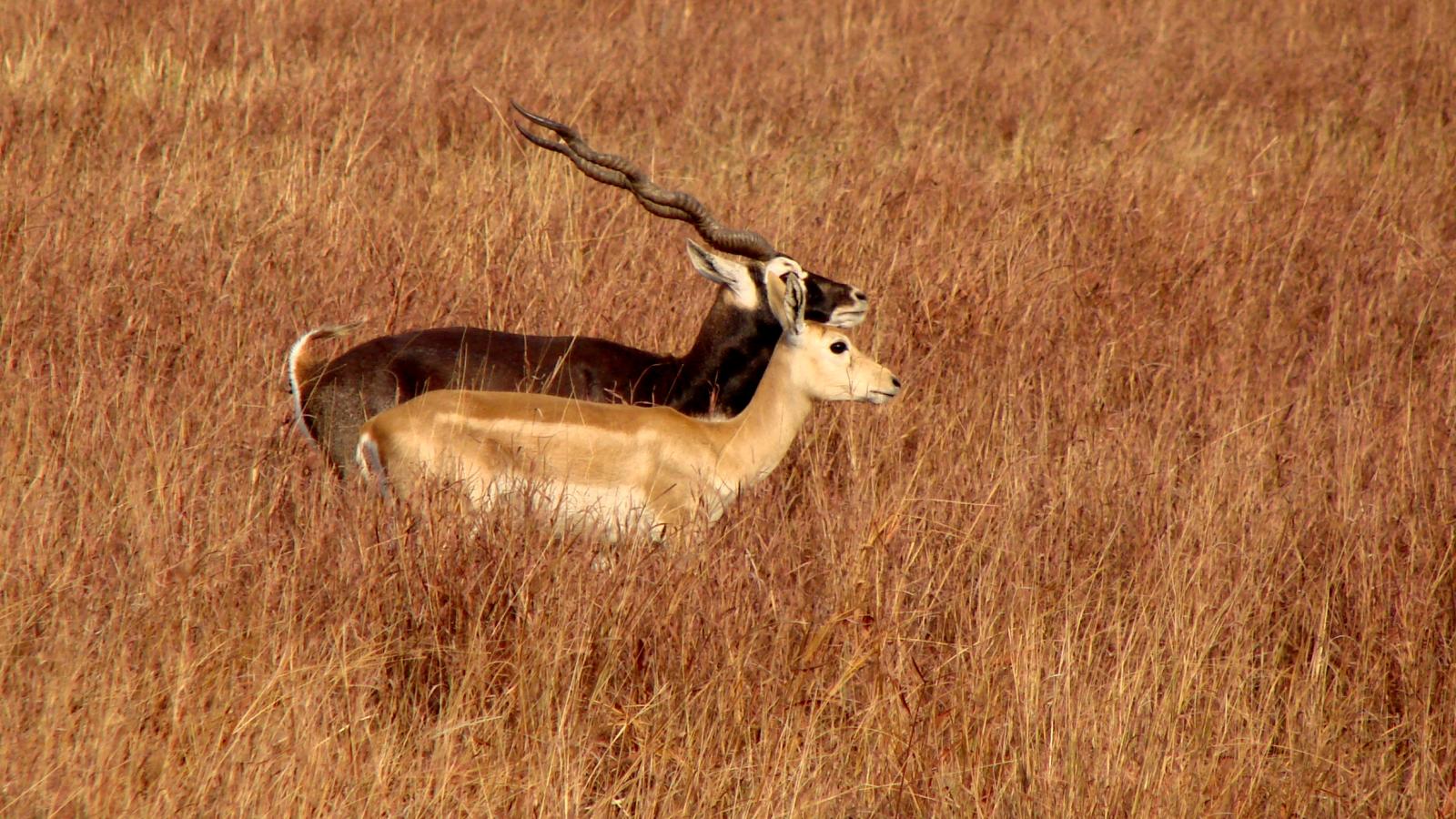
Male and female blackbucks (Antilope cervicapra), Blackbuck National Park, Gujarat, India, 2009. Photo by Sankara Subramanian (flickr, Creative Commons Attribution 2.0 Generic license).
Terai-Duar savanna and grasslands
The sub-Himalayan grasslands, called the Terai-Duar savanna and grasslands, are the world’s tallest grasslands. Occupying land in India, Nepal, and Bhutan, they have grasses that may reach heights of 7 meters (about 23 feet)! Temperatures in the Terai-Duar grasslands can reach 40ºC (104ºF) in the summer and get cold enough for frost in the winter. There is a cycle of monsoonal flooding, with distinct wet and dry seasons throughout the year. This region is home to large mammals, like Bengal tigers (Panthera tigris tigris), elephants, and rhinos.
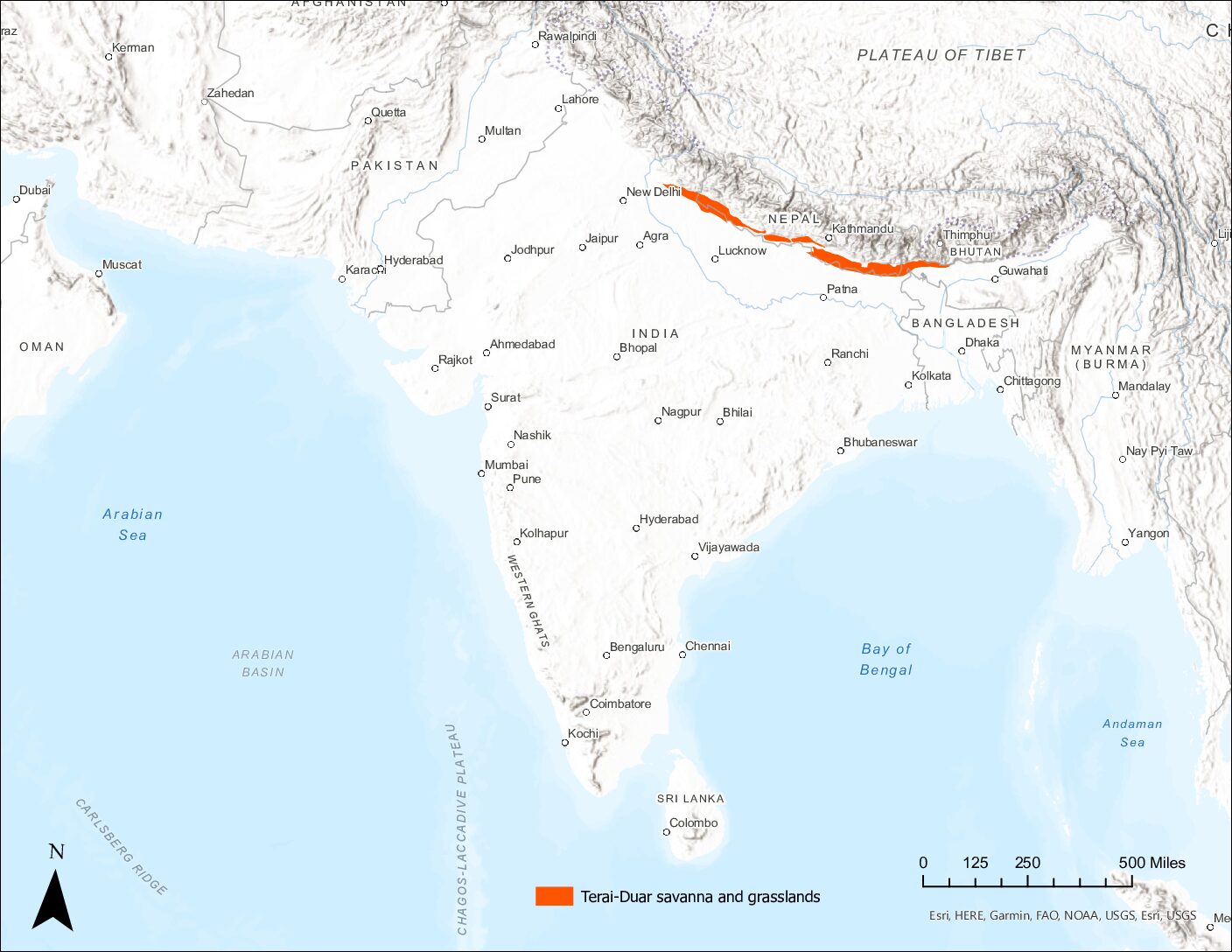
Map of Terai-Duar savanna and grasslands in India, created by N. Schulberg.

Indian elephants (Elephas maximus indicus), Dhikala grassland, Jim Corbett National Park, Uttarakhand, India. This grassland is part of the Terai-Duar savanna and grasslands complex. Photo by Kaushik mailbox (Wikimedia Commons, Creative Commons Attribution-ShareAlike 4.0 International license, image resized).
Indian species spotlights
Cogongrass (Imperata cylindrica)
Cogongrass (Imperata cylindrica) is a perennial C4 species of grass that grows from 0.6 to 3 meters (about 2 to 10 feet) tall and is found in areas prone to drought and fires. It spreads rapidly via rhizomes, which account for an average of 60% of its biomass, and is highly flammable.
Cogongrass is not native to India and is recognized as a globally distributed weed; in India, it is considered a problem in areas prone to fire because it outcompetes and displaces other plant species. Nevertheless, it is now a major part of some Indian grassland ecosystems (particularly semi-arid grasslands of the Gangetic and Punjab plains and the Brahamputra Valley) and is used for thatching.
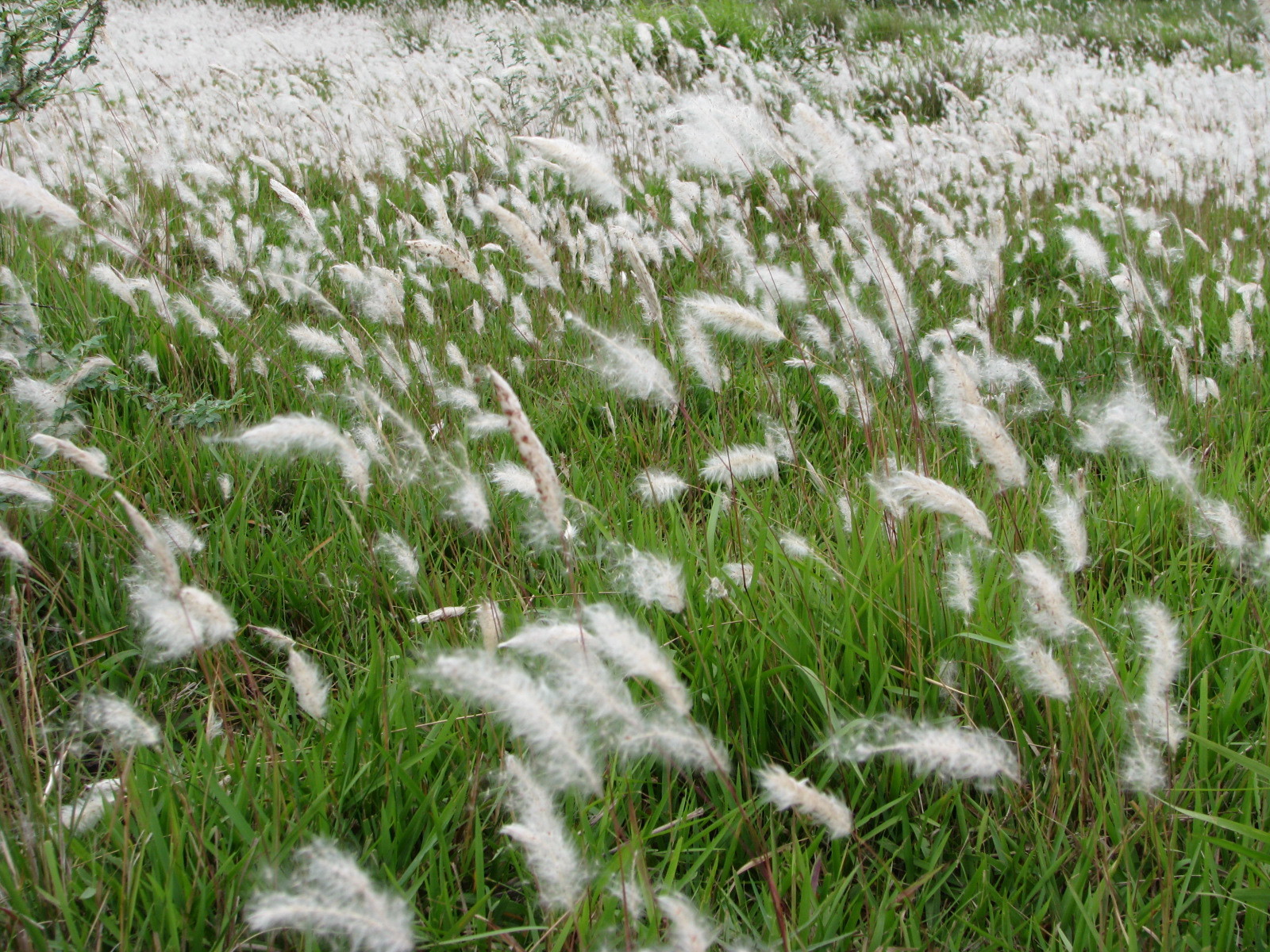
Cogongrass (Imperata cylindrica), Kranataka, India, 2009. Photo by shivaprakash (iNaturalist photo 157499060, Creative Commons Attribution-NonCommercial 4.0 International license).
Tanglehead (Heteropogon contortus)
Tanglehead is a perennial C4 grass that can reach 0.9 to 2.4 meters (3 to 8 feet) in height. It is widely distributed and considered native throughout the tropics worldwide. The common English name of the grass is derived from the appearance of the spikelets, which have long, tangled awns when mature. This species is an important component of semi-arid grasslands in several Indian regions.
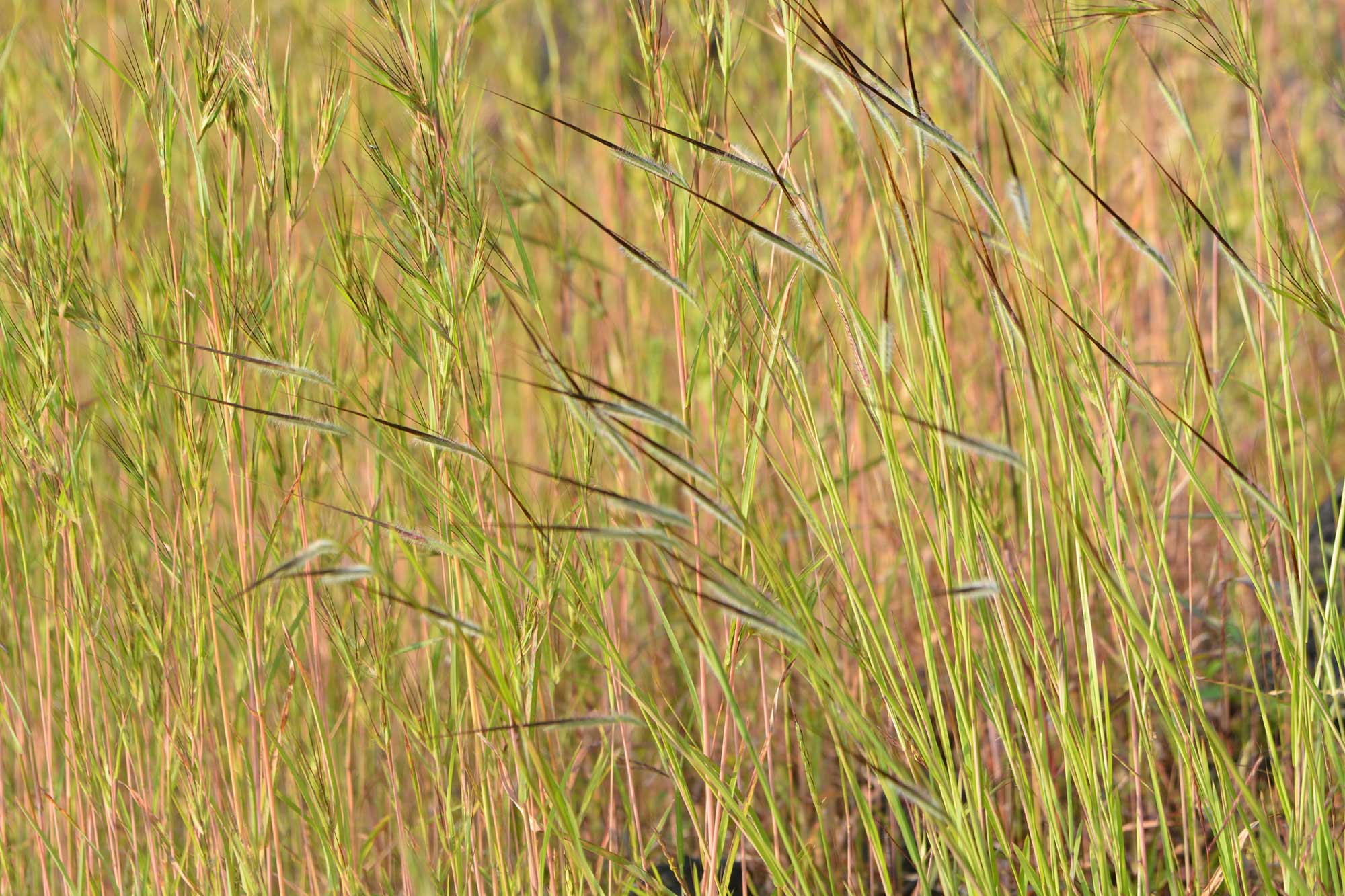
Tanglehead (Heteropogon contortus), Maharashtra, India, 2021. Photo by S.MORE (iNaturalist photo 166385705, Creative Commons Attribution-NonCommercial 4.0 International license, image resized).
Buffelgrass (Cenchrus ciliaris)
Buffelgrass is a perennial C4 bunchgrass that grows to from 10 to 150 centimeters (about 4 to 59 inches) tall. Like many other perennial grasses, it spreads horizontally by rhizomes or stolons. Buffelgrass is an important part of arid and semi-arid grasslands in northwestern India.
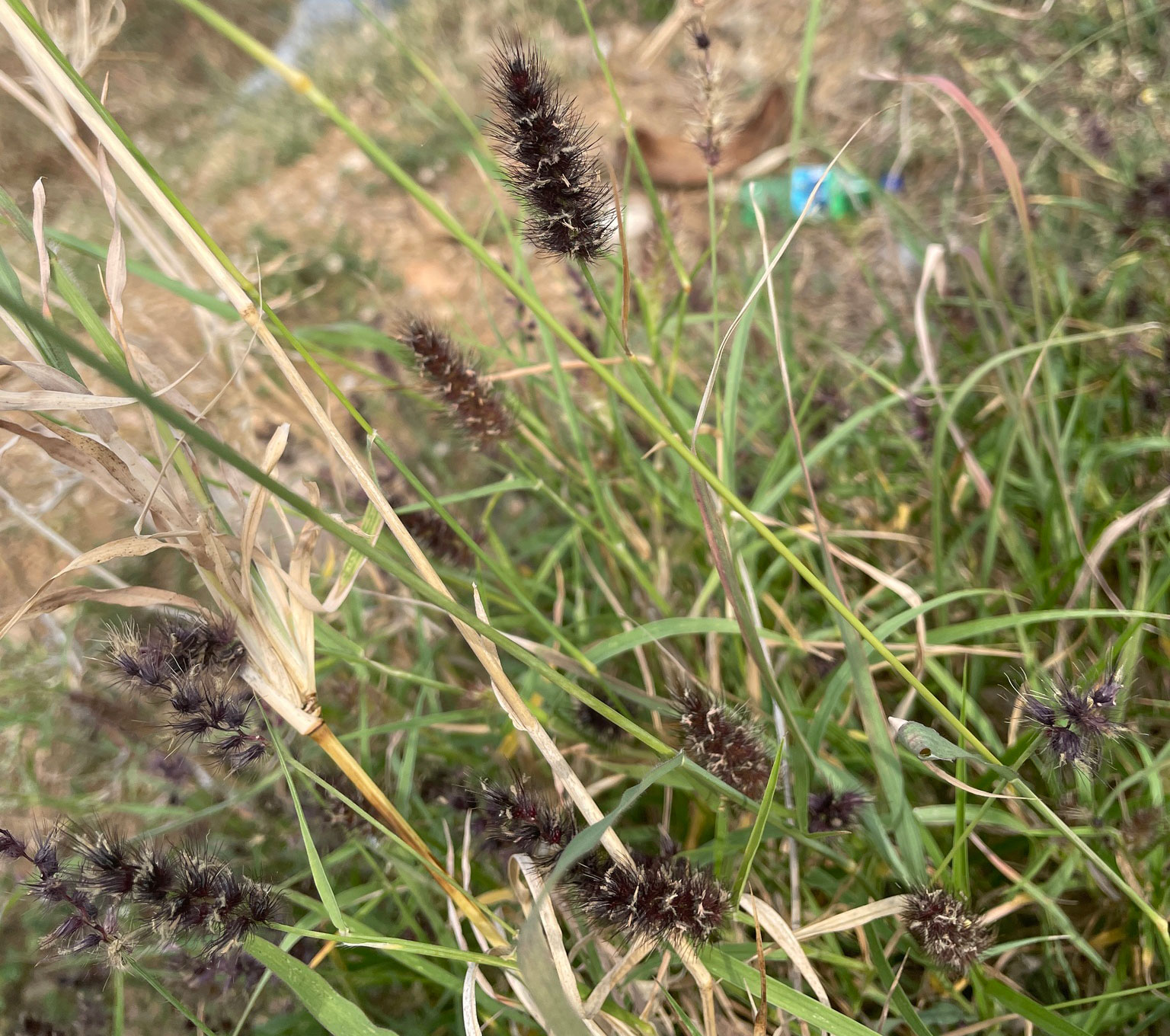
Buffelgrass (Cenchrus ciliaris), Coimbatore, Tamil Nadu, India, 2023. Photo by Gnan Vi (iNaturalist photo 271568719, Creative Commons Attribution-NonCommercial 4.0 International license, image cropped).
Mauritian grass (Apluda mutica)
Mauritian grass is a perennial C4 grass species that is native to Asia and grows up about 3 meters (nearly 10 feet) tall. It is an important part of humid to sub-humid grasslands of northern India, including the Terai-Duar region.
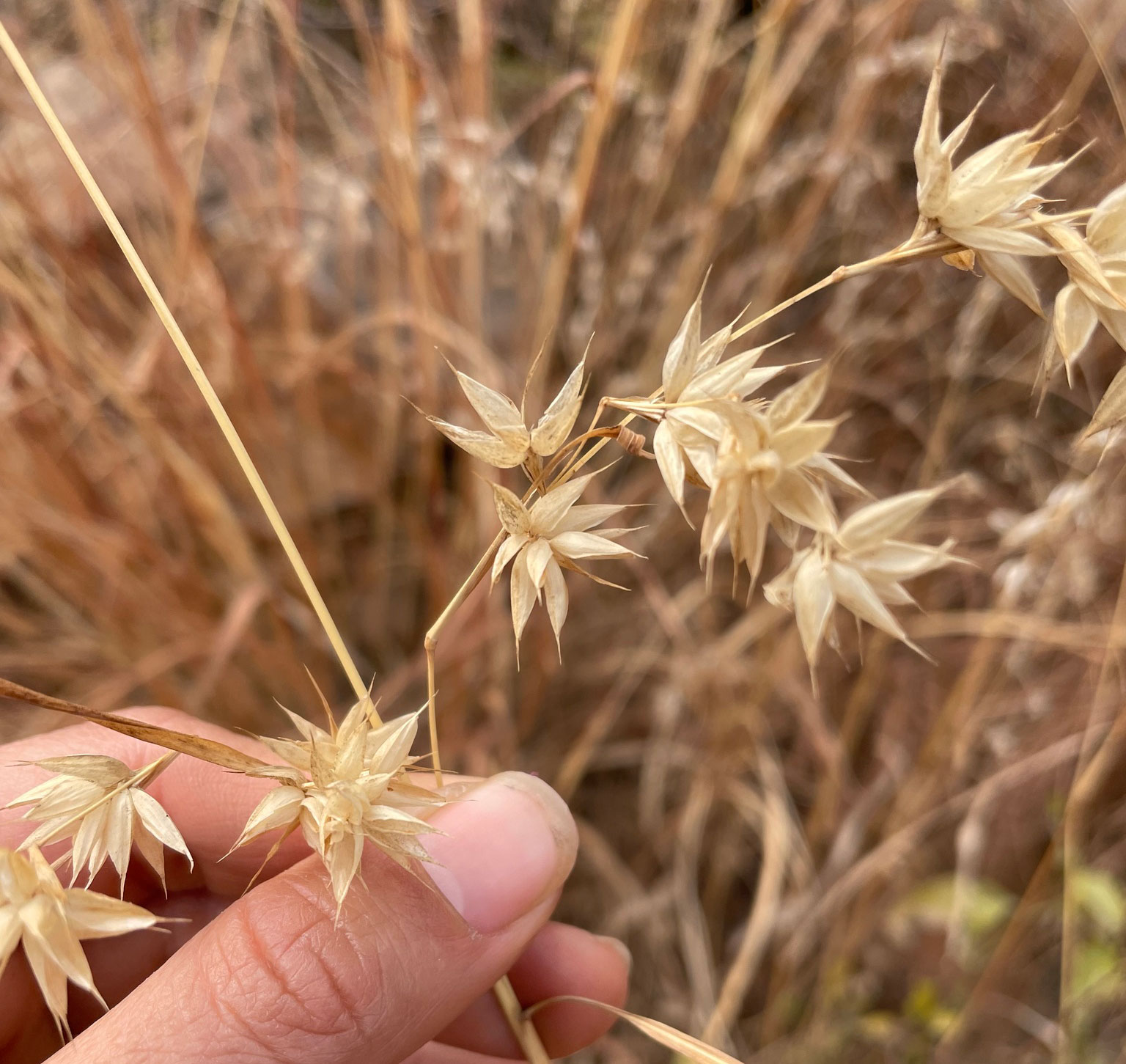
Mauritian grass (Apluda mutica), Jaipur, Rajasthan, India. Photo by panurl27 (iNaturalist photo 252913603, Creative Commons Attribution-NonCommercial 4.0 International license, image cropped).
South American cerrado
Overview of South American cerrado
The cerrado, the world’s most biodiverse savanna, is located mostly in Brazil. Average temperatures range between 22ºC and 27ºC (72ºF to 81ºF) throughout the year, and there are distinct wet and dry seasons. The dry season occurs from April to September, and the wet season occurs between October and March. Overall, precipitation ranges between 800 and 2000 millimeters (about 31.5 to 79 inches), making the area wetter than most other savannas.
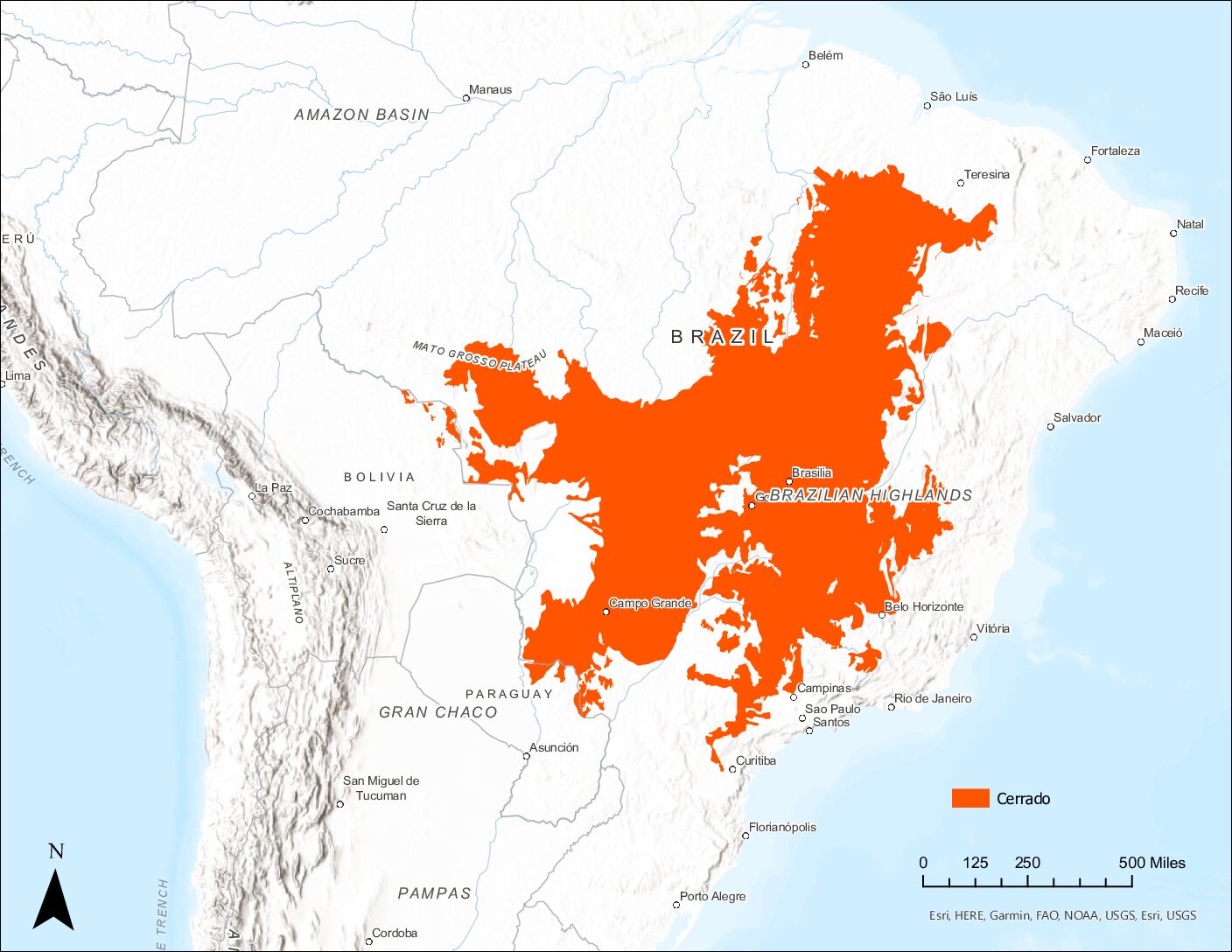
Map of Cerrados, created by N. Schulberg.
The vegetation of the cerrado is heterogeneous. The herbaceous layer, consisting mostly of grasses but also sedges and herbaceous legumes, can be up to 60 centimeters (about 24 inches) tall. Trees are also scattered throughout the landscape; they are mostly members of the legume family (Fabaceae), such as acacias (Acaciella and Mariosousa).
The cerrado contains many endemic species of plants and animals. Overall, about 10,000 species of plants occur there. Animals include lizards, such as the giant ameiva (Ameiva ameiva); a high diversity of snakes; birds such as the hyacinth macaw (Anodorhynchus hyacinthinus) and Brazilian merganser (Mergus octosetaceus); and mammals such as the maned wolf (Chrysocyon brachyurus), giant armadillo (Priodontes maximus), and giant anteater (Myrmecophaga tridactyla).

Cerrado, Goiás, Brazil. Photo by Eliane de Castro (Wikimedia Commons, Creative Commons Attribution-Share Alike 4.0 International license).
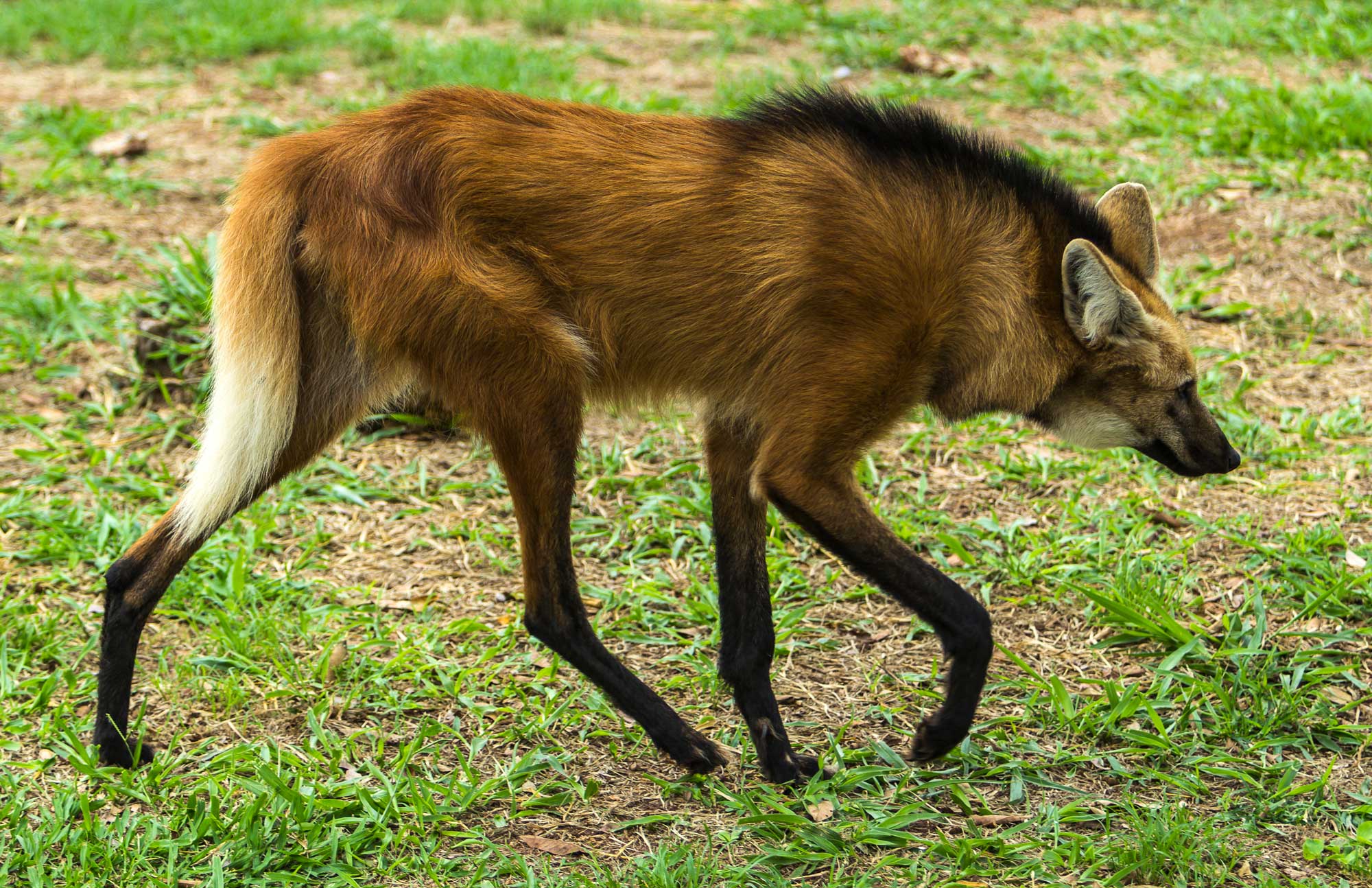
A maned wolf, Brazil. Photo by Jonathan Wilkins (Wikimedia Commons, Creative Commons Attribution-Share Alike 3.0 Unported license, image resized).
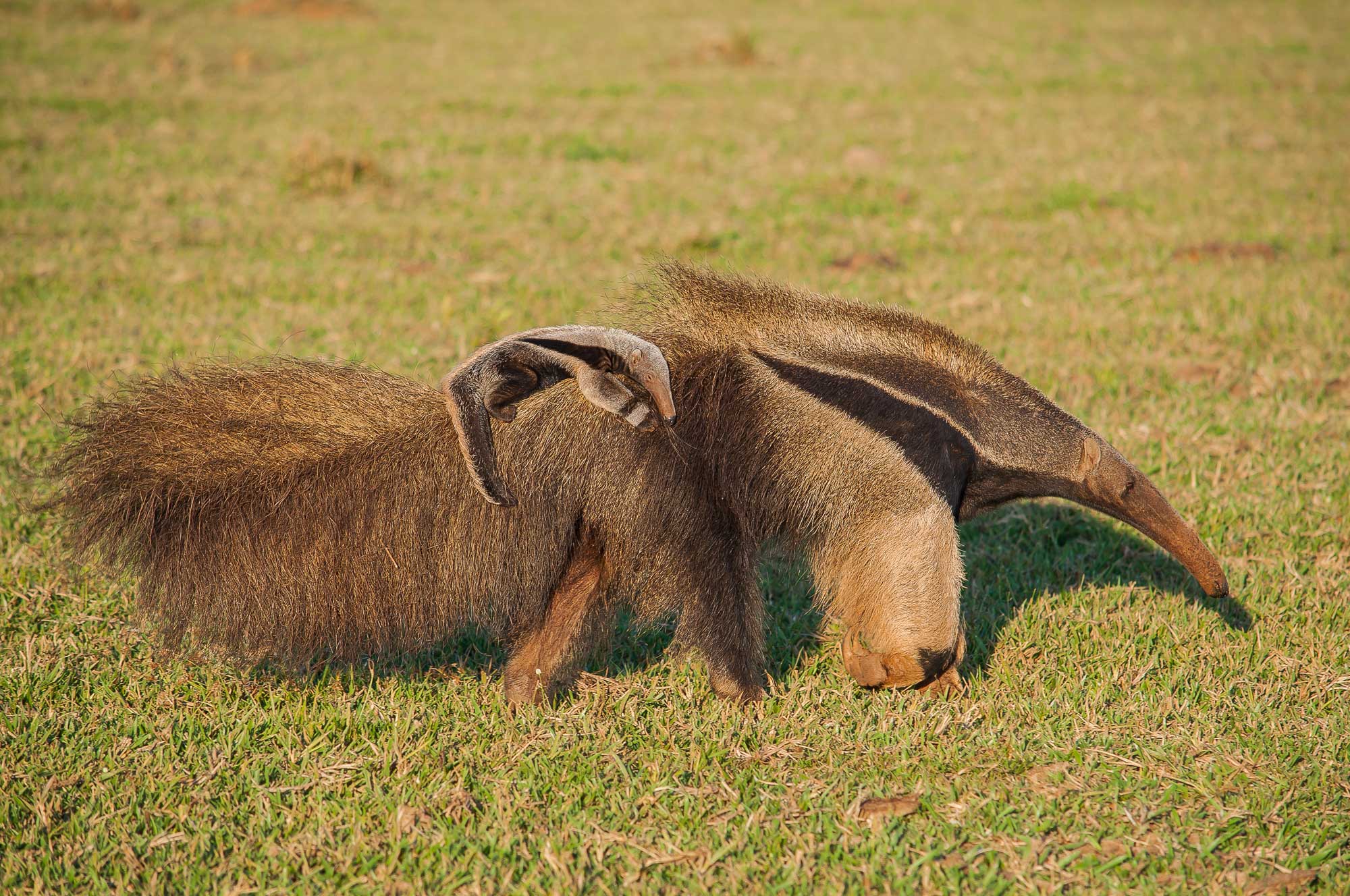
A giant anteater carrying its baby near Campo Grande, Mato Groso do Sul, Brazil. Photo by Marcelocalazansbrasil74 (Wikimedia Commons, Creative Commons Attribution-Share Alike4.0 International license, image resized).
Cerrado species spotlights
Capim flechinha (Echinolaena inflexa)
Capim flechinha (the English translation of the Portuguese name is "arrow grass") is a C3 annual or perennial grass found in many habitats, although is often dominant in marshlands. It reaches heights of up to 1 meter (more than 3 feet) and has leathery leaf blades and an inflorescence that is 1 to 5 centimeters (about 0.4 to 2 inches) long.
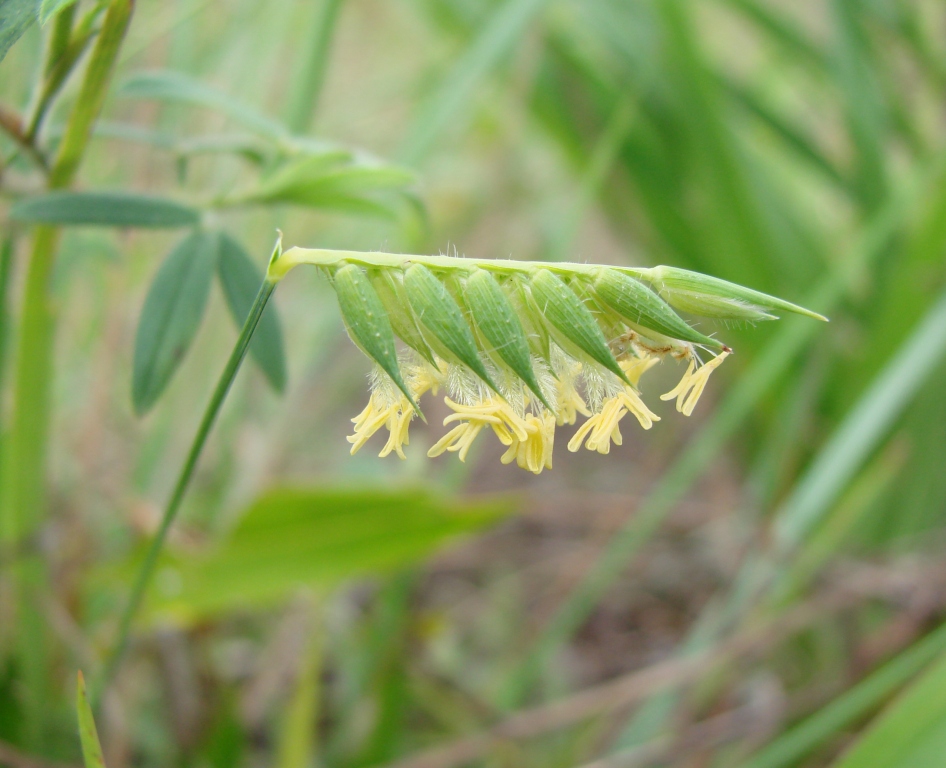
Capim flechinha (Echinolaena inflexa), Parque Estadual da Serra dos Pirineus, Goiás, Brazil. Photo by João Medeiros (Wikimedia Commons, Creative Commons Attribution 2.0 Generic license).
Axonopus pressus
Axonopus pressus is a C4 perennial species found in western Brazil. It is a geophyte and has many rhizomes. It has a racemose inflorescence.
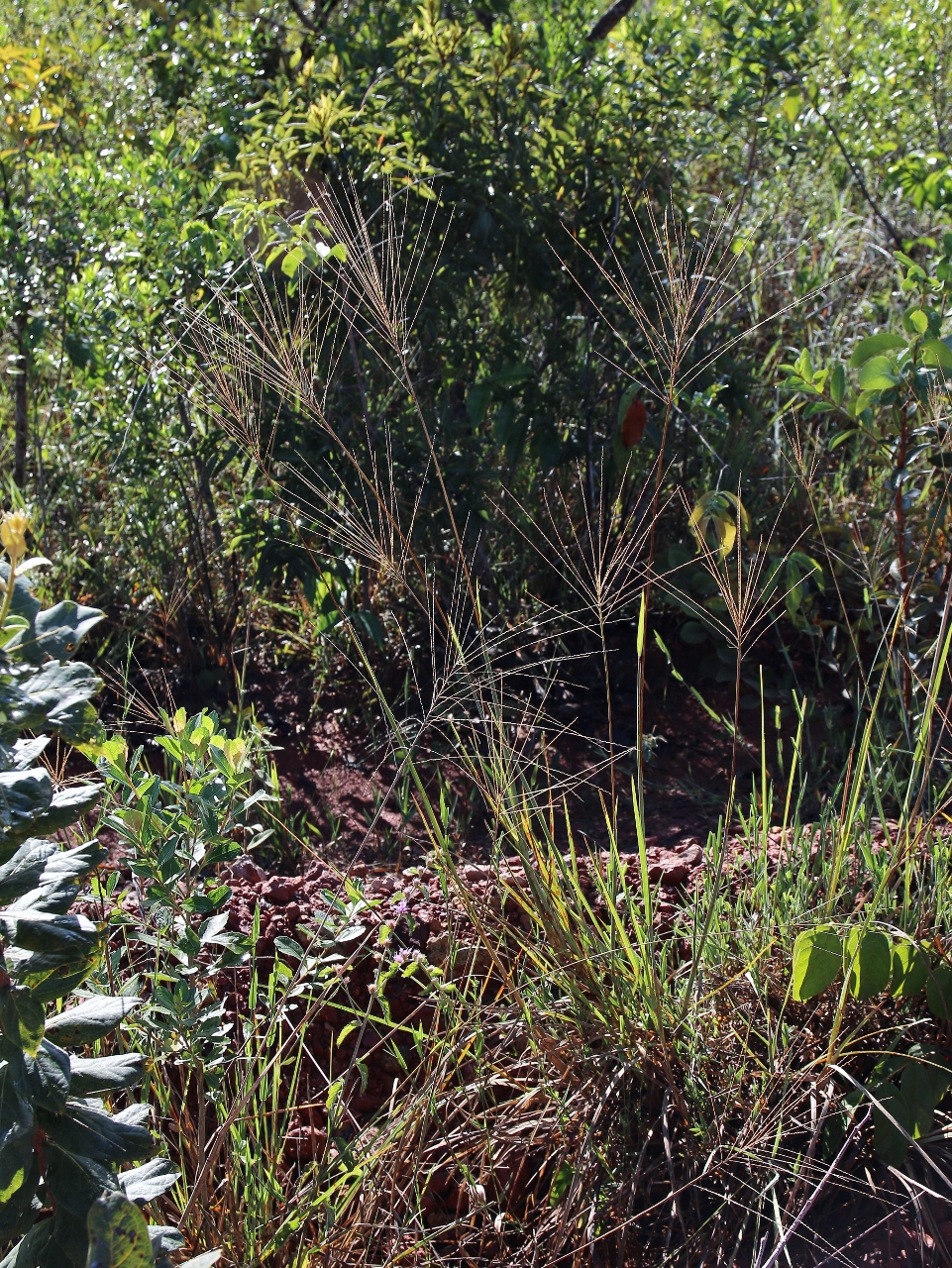
Axonopus pressus, cultivated, Brasília, Brazil. Photo by Mauricio Mercadante (flickr, Creative Commons Attribution-NonCommercial-ShareAlike 2.0 Generic license).
Loudetiopsis chrysothrix
Loudetiopsis chrysothrix is a C4 perennial species found in Brazil and also in parts of Africa. Grasses in the genus Loudetiopsis can grow up to 120 centimeters (about 47 inches) tall, and the female florets have conspicuous long awns.
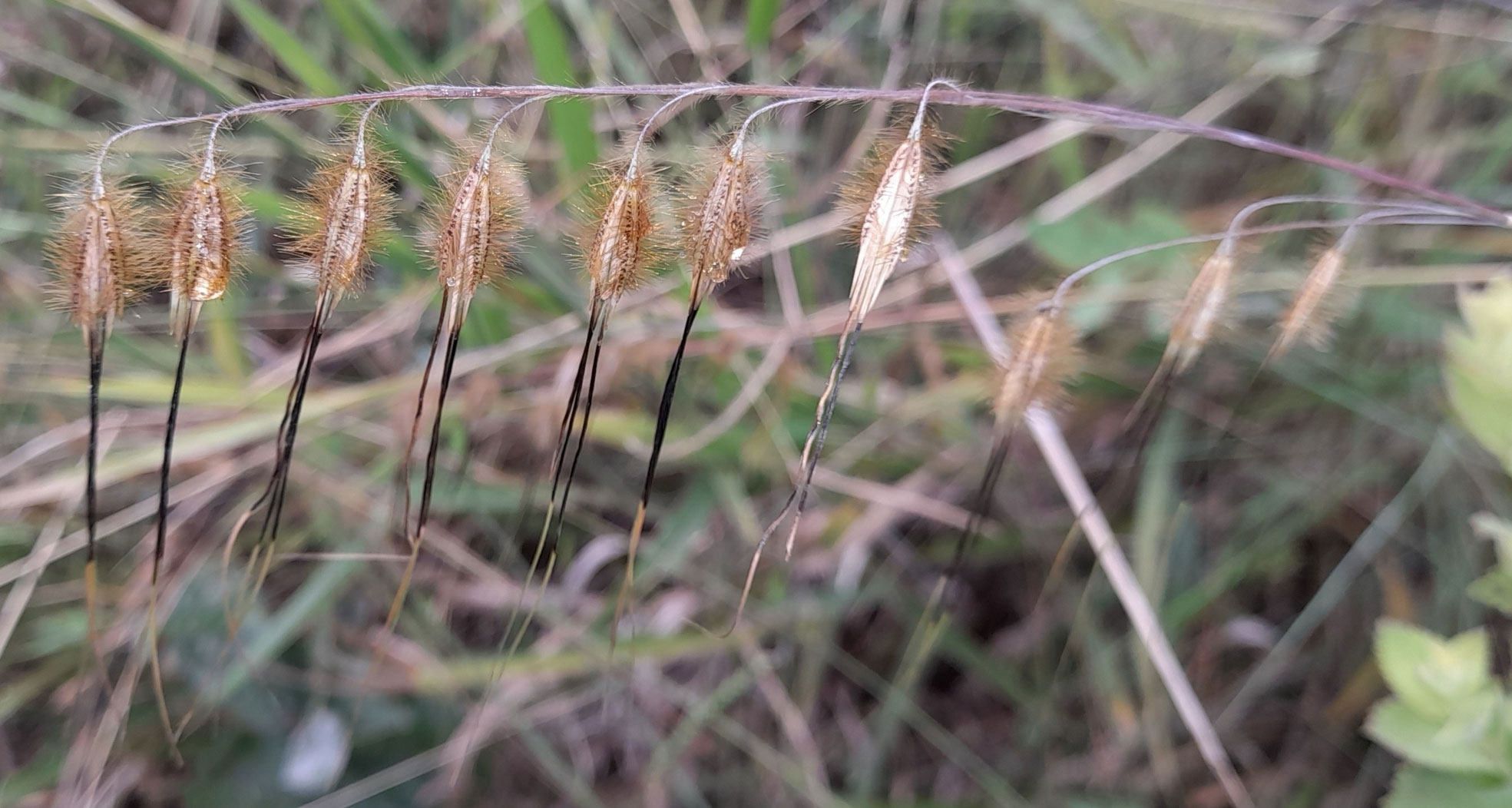
Loudetiopsis chrysothrix, Minas Gerais, Brazil. Photo by Rafael Silva (iNaturalist photo 265807999, Creative Commons Attribution-NonCommercial 4.0 International license).
Leafy skeletongrass (Gymnopogon foliosus)
Leafy skeletongrass is an annual C4 species that is native to the Caribbean and South America. It grows to be 10 to 30 centimeters (about 4 to 12 inches) tall and has a racemose inflorescence.
Resources
Websites
African Savanna biome (Maya S., Blue Planet Biomes): https://www.blueplanetbiomes.org/african_savanna.php
Cenchrus ciliaris (Weeds of Australia): https://keyserver.lucidcentral.org/weeds/data/media/Html/cenchrus_ciliaris.htm
Cerrado (J. Schipper, One Earth): https://www.oneearth.org/ecoregions/cerrado/
The grass genera of the world (L. Watson, T. D. Macfarlane, and M. J. Dallwitz, 1992 onwards): delta-intkey.com
Themeda triandra (Kangaroo grass) (NSW Department of Primary Industries): https://www.dpi.nsw.gov.au/agriculture/pastures-and-rangelands/rangelands/publications-and-information/grassedup/species/kangaroo-grass
Articles, reports & book chapters
Damasco, G., C. Fontes, R. Françoso, and R. Haidar. 2018. The cerrado biome: a forgotten biodiversity hotspot. Frontiers for Young Minds 6: 22. https://doi.org/10.3389/frym.2018.00022
McIvor, J. G. 2005. Australian grasslands. In: Grasslands of the World, J. M. Suttle, S. G. Reynolds, and C. Batello (eds.) Food and Agriculture Organization of the United Nations Plant Production and Protection Series 34. https://www.fao.org/3/y8344e/y8344e0g.htm
Rawat, G. S., and B. S. Adhikari (eds.). 2016. Ecology and management of grassland habitats in India. ENVIS Bulletin 17. https://wiienvis.nic.in/WriteReadData/Publication/19_Grassland%20Habitat_2016.pdf
Tu, M. 2002. Element stewardship abstract for Cenchrus ciliaris L. The Nature Conservancy. PDF: https://www.invasive.org/gist/esadocs/documnts/cenccil.pdf
Scientific articles
Hidore, J. J. 2005. Savanna climate. In: Oliver, J. E. (ed.) Encyclopedia of World Climatology. Encyclopedia of Earth Sciences Series. Springer, Dordrecht. https://doi.org/10.1007/1-4020-3266-8_176



